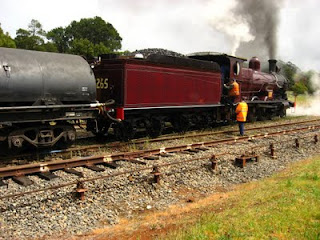Well, the time has come for an update. The main reason this blog was started was to have a more permanent record of the places in Robertson and Mossvale we can recommend for food and shelter. The ongoing reason for this blog, though, will be trains. Large and small trains, but mostly small as my life in Canberra precludes regular association with large trains; 12 inches to the foot scale!
My current small train project is a bringing together of a number of ideas that have been floating around in various stages this year. One of those ideas is a reflection on the popular conception of model railroading which was summed up in a work mate's question about me having model trains at home. It went something like, "Do you have mountains and trees? tunnels and bridges?" I wish to say from the outset that this is an excellent question and puts a real dampener on much of the petty stuff that passes between modellers and rail fans. Those not in the train fraternity would not necessarily know the difference between a riveted and a welded tender and if they do, they probably don't really care, and I say shouldn't have to.
So came idea one: for the enjoyment of as wide an audience as possible, a model should have the afore-mentioned elements i) mountains ii) trees iii) tunnels iv) bridges. In a shopping centre near my workplace, a Riot! craft store had recently opened and as it was mid-winter here, had a display using craft elements to create a winter scene. White expanse populated by snow men made from polystyrene balls, glitter, snowflakes, etc.
And along came idea two: have a winter scene, a train running through winter snow. Now nowhere in Australia that I know of do trains run in snow covered scenes, except for freak weather conditions which send rail fans out with their cameras. "Luckily" I run Northern American trains in the scale I wanted to make my next train project in. I say "luckily" because at times following an overseas prototype has had its challenges. Australian Christmases are a time of cold cuts, barbecues, salads, rusty Holden Utes and kangaroos pulling Santa's sleigh because it is high summer here; cyclones and bush fires can be Christmas visitors here in Australia. But as previous, I model northern hemisphere trains and so Christmas is snow, cold, roasting chestnuts, open fires and so on.
And then as idea one and two floated together, idea three began to grow: the next project could be a model where a Christmas tree plays a central part. Northern hemisphere prototype, north American prototype, more specifically Union Pacific prototype.
The Union Pacific goes back as far as being part of the first railroad to cross the United States, known as The Continental Railroad in some circles due to the American transcontinental being the first to cross a continent anywhere in the world. At the joining of the two sides of the transcontinental, a ceremony of great pomp and circumstance took place and centre stage where two trains, one from each railroad. The steam power at the front of the Union Pacific train was 119, of which I have a model in my collection, and some old style Union Pacific coaches. And what type of bridge does such a train travel over? An equally old style wooden trestle bridge, of course!
So the ideas coalesce: A winter scene with mountains, tunnels, trees, a wooden trestle bridge and a way to work this into the base of a Christmas Tree. Fortunately from a previous rental property I had a wooden base that had supported some cupboards but now could do other duties. So all the pieces were together in my head, now how to make them a reality? Join me in the next part of the journey in Chapter One.
P.S. And to whet the appetite, here's a photo of some trials of concepts. Can you spot the wheels not on the rails? I didn't till I enlarged the photo for editing. Now I see why so many photos end up getting published with such "mistakes": the proof of concept has since done its work and to set up another such photo would require much rework. So in this, what you see is what you get, sorry folks :-(












